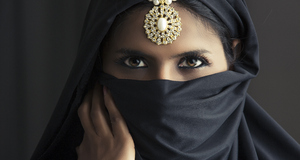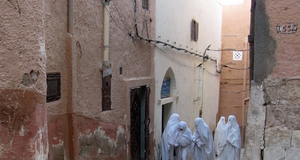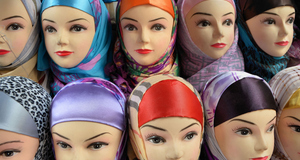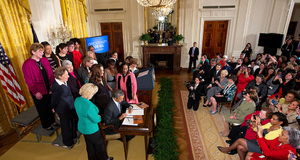Women's Motivations and Roles in Islamist Organizations
By
2016, Vol. 8 No. 05 | pg. 1/1
IN THIS ARTICLE
KEYWORDS
It is a common misperception that Islamist organizations are men’s groups. Some, like the Muslim Brotherhood, even involve specifically gendered names, or include other references to “brothers” and “brotherhood.” Beyond exclusive language, Islamist organizations most frequently recruit among young men and feature gender-segregated spaces with all-male leadership. In the West, Islamists are widely regarded as misogynists and little distinction is made between mainstream organizations like the Muslim Brotherhood and violently oppressive organizations like the Taliban. Thus, Islamist women have traditionally been invisible to the West, but they have been a fixture of most Islamist groups since their founding. Zaynab al-Ghazzali, for example, founded the Muslim Women’s Association in 1933 and worked personally with Hassan al-Banna, the founder of the Muslim Brotherhood before his death in 19491,2. Today, women in Islamist organizations are not only wives and sisters of Islamist men, but middle-class, educated women who represent Islamist parties in parliament, hold leadership positions within the organizations, and provide social services to marginalized members of society.3 In my research, I have found that women in Islamist groups are motivated by a sense of collective rights within an ever-important Islamic frame of reference (marjaiyya islamiyya), and consider their status as women and individuals to be derived from and protected by Islam. They reject a Western notion of feminism as individualist, as they perceive women’s rights to be bundled as a part of an Islamic society (nizam islami) that they desire to realize.4In order to bring about this society, they hold a variety of roles, and often take on such roles before the organizations have taken an official stance on the issue.5 Through this ad-hoc method, women are able to claim space and push Islamist organization’s boundaries in the name of pragmatism, while always justifying their roles with the marjaiyya islamiyya. IncentivesThe incentives for women to join Islamist organizations are surprisingly similar to those of men. In many cases, mainstream Islamist organizations are the best opposition to oppressive governments. Joining an Islamist organization is seen by middle-class, educated women as a means of protesting the regime, or in the case of Hamas, the Israeli occupation. Women who join Islamist organizations view their rights as part of a whole (the creation of a nizam islami), not as individual rights or an issue separate from that of their nation and its cultural and political integrity6. Like men who join mainstream Islamist groups and voters who support them, women are often middle-class and can “afford” to be ideological about their politics78. Women who represent such organizations are educated, but this does not mean that poor women do not affiliate themselves with Islamist organizations. Their participation is most often tied to their class, not their gender, and usually involves receiving social services rather than direct action for the organization9. I contend that this support is tied much more to their class than their gender, as Tarek Masoud observes a similar pattern across poor areas in general in Egyptian elections, where the poor may receive social services and ideologically support the Muslim Brotherhood but cannot afford to express political support in elections or political demonstrations10. The prevalence of patronage ties between poor voters and rich candidates precludes poor voters from voting for Islamists who may share their values, as Masoud discusses. In this essay, I do not consider forced conformity to Islamist ideals to be participation in Islamist organizations, and when I refer to women participating in or affiliating with Islamist groups, I am speaking about women who do so willingly. A special case is that of Hamas in Palestine (particularly in Gaza), where conformity with Islamist principles was imposed on women during the first intifada in 1987 and continues today11. With the claim that “the moral nation needs moral women,” Hamas claimed that Israeli intelligence used immoral women to degrade Palestine and Hamas’s strength, which they considered to be derived from Islamic values; in an effort to cleanse and strengthen Palestinian resistance against Israel, 107 women were killed by Islamist organizations between 1988 and 199312. While the notion that the formation of a nizam islami necessarily entails female morality and the emphasis on collective rights typically supersedes that on individual rights in Islamist groups, this is an extreme case. Though I will refer to women participating in Hamas, I have done my best to separate this forced conformity with the affiliation of women who actively and willingly participate in the group. The majority of women who participate in Islamist groups make a choice to do so, and risk torture, imprisonment and death under authoritarian governments by their participation (this is particularly true for women who affiliated themselves with the Muslim Brotherhood in Egypt in the Nasser era and today). This is a nuanced topic, and choice is not always easily determined from the outside. For example, the practice of veiling is often considered oppressive by Westerners. In the case of forced veiling under Hamas, I would agree. However, the spread of veiling among university women in Iran before the 1979 Revolution was taken on as a conscious rebellion against Westernization and was a free choice made by educated women; I would argue that this is not oppressive13. In this essay, I generally consider women’s choices to be more free than not, but there remains substantial room for debate in certain cases. Women’s Roles in Mainstream Islamist OrganizationsWomen’s (or sister) organizations have long existed alongside male-dominated Islamist organizations. As some of the oldest and most established female spaces in Islamist movements, women’s participation and even leadership in women’s groups is significantly less controversial than many other roles women have agitated to play in recent years. Women’s organizations affiliated with the Islah party in Yemen and Islamic Action Front (IAF) in Jordan are longstanding institutions; so is the aforementioned Muslim Women’s Association14. The roles of these organizations, however, are dynamic. Traditionally confined to “women’s issues,” they have increasingly agitated to play a larger role in party doctrine and policy. As discussed below, women who compete for party leadership positions most often emerge from leadership roles in the women’s sectors of organizations, where they amass experience and popularity in the group. The rise of Islamist political parties, accompanying the tentative spread of democratization in the Middle East, has allowed women to participate in political arms of Islamist organizations which did not previously exist. In other words, Islamist movements tend to be older than their political wings, and the creation of these wings leads to uncertain power relations where women are concerned. The second longstanding gender-inclusive institution in Islamist organizations is the student group (jama’a). The Muslim Brotherhood in Egypt, for example, has maintained active student wings both as a basis for recruitment of young people and as a part of it’s da’wa mission, and often ran candidates for student unions in more tolerant times15. Hamas, which traditionally has been one of the most hostile Islamist organizations in terms of women’s participation, allowed university women to participate in student organizations even when it forbade them from further activism after graduation16. The jama’at played vital roles in spreading the Islamist’s da’wa message: they promoted Islamic values by interrupting parties with alcohol, made observance of Islamic standards of modesty possible by providing gender-segregated micro-buses for female students, provided social services like tutoring and Qur’an classes, and protested un-Islamic actions by the university and students, such as alcohol consumption and premarital romantic relationships17. Women’s activism in the jama’at is long established and relatively uncontroversial18. Women’s participation is much more contested in two areas: parliamentary representation and party leadership. With greater democracy in many Muslim-majority countries after the Arab Spring, parties such as the Parti de la justice et du développement (PJD) in Morocco, Ennahda in Tunisia, the IAF in Jordan, and Islah in Yemen have grappled with the question of women’s roles in Islamist groups’ political wings. While one may anticipate hard-liner opposition to women’s representing Islamist groups in public life, the reality is more complex. Both the PJD and Ennahda have women representatives in parliament, though these women do not follow the Western expectation of espousing “feminist” agendas for gender equality. For example, Ennahda member Souad Abderrahim proposed legislation to strip protections from children born out of wedlock, arguing for the interest of society and collective morality19. This emphasis on women’s rights as part of a whole, and that whole being a nizam islami, are common among Islamist parliamentarians, regardless of gender. It is safe to say that women in Islamists concern themselves first with their religious identity, not with their gender. Further, women’s representation in parliament does not signify consensus within Islamist organizations about women’s roles. Rather, it indicates whether reformists or traditionalists have an upper hand in the organizations; there are both factions in all Islamist organizations20. Lastly, the greatest shift in women’s roles in Islamist organizations has occurred within group leadership itself. Women like Nawal Faouri of the IAF, who began in the women’s organization parallel to the IAF, have increasingly agitated to hold decision-making positions in the group leadership21. A similar phenomenon has occurred in Hamas in Palestine and Islah in Yemen, which are much more historically conservative regarding women’s status. Women’s holding leadership positions does not necessarily indicate an immediate shift in ideology, and is often not preceded by lengthy religious arguments. Rather, openings in leadership are contested by or filled by women, and debate follows their success or failure22. Pragmatism, therefore, proceeds doctrine, which is filled in later. Women do not justify their fulfillment of these roles as simply ad-hoc practicality, however. The ever-elusive marjaiyya islamiyya is invoked by all sides in debates about women’s status. In Hamas, for example, women argue that Palestinians face a numeric disadvantage and need as much involvement as they can maintain to combat Israeli occupation. Women are a foundation of the nation, they argue, and Islamist women are necessary for an Islamist nation strong enough to face a Western-backed enemy. The prevalence of widows and unmarried women in leadership positions bolsters their argument, because these women do not have families they could be considered to neglect by their leadership. The argument that is not made, however, is that these women are the wives, sisters, or daughters of prominent Hamas leaders23. This highlights the variation among groups; women who hold leadership positions in the Muslim Brotherhood are often the wives and widows of prominent Brothers24. Consistently, though, similar arguments are made: so long as women are not neglecting their family duties or in violation of shari’a, they have a right to follow the examples set by the Prophet’s own female family members in realizing a nizam islami. What precisely would put a woman in violation of shari’a is the subject of various debate, and the refrain of “the text does not prohibit” has become a key to women’s arguments for their involvement in more high-ranking bodies of Islamist groups25. Women’s Rights in Marjaiyya IslamiyyaThe marjaiyya islamiyya is central to any discussion of women’s rights in Islamic organizations. Islamist women thoroughly reject Western-style feminism as dangerously individualist and poorly focused26. Like other Islamists, Islamist women do not primarily identify as women, as Egyptians or Jordanians, or as members of a particular class, but first and foremost as committed Muslim women (moltazemaah). They consider their rights to be defined and enshrined by Islam, and so the realization of an Islamist society will inherently improve their lives and rights, they argue27. A crucial factor in understanding Islamist women is understanding not only their focus on Islam, but their focus on family. According to Islamists, the central unit of any country or society is not the individual, but the family28. Islamists, both men and women, invariably condemn Western society as a whole, and Western notions of women’s rights in particular, as too individualist. Islamist Palestinian writer Nehad al-Sheikh Khalil explains: “In criticising feminist calls for women’s rights based on the notion of individual rights, he stated that ‘the individual self cannot be the measure for development, since this might contradict the public good of the society’ (ibid: 6). An example, he suggested, would be a Palestinian working in an Israeli settlement or workshop.” The same author, however, insists that women have a right to healthcare, family planning, delayed marriage, and dignity in the family. Women are not simply to be subordinated or sacrificed for the good of the cause, al-Sheikh argues, but their roles cannot be considered a separate issue from that of Palestinian liberation29. In a less nationalist context than that of Hamas, the argument remains similar. In Egypt, Aboul ‘Ela Madi, an Islamist from the Wasat Party, criticized the idea of absolute freedom at the expense of “religious and moral values of this society” and insisted that the party “define [the values of society] so that no one oversteps them or adds anything to them”30. This priority with collective Islamization of society is precisely the marjaiyya islamiyya. So long as women’s rights are considered as a part of the whole, rather than specifically a women’s issue, they are acceptable. In this way, women’s rights become a form of public good: everyone in an Islamic society benefits from moral women fulfilling roles prescribed them by the Qur’an and Sunnah, as this creates a more Islamic society for men and children as well as the women themselves. ConclusionThe separation of women from the whole of Islamic society, and particularly their consideration as autonomous actors apart from the family, significantly decreases support for women’s rights initiatives. Though Islamist women often do support many of the same initiatives as secular feminists—greater access to reproductive care, for example—the motivation of the initiatives is crucial. Islamist women will often fight secular feminists who argue for the same initiative they do out of fear that they as women are being co-opted by the West and its quest to degrade Muslim society by framing women’s rights as those of individuals derived from human rights law rather than Islamic text or tradition. Islamist women seek a different perspective on women’s rights, but they nevertheless support them. Regardless of the name, they are often at the forefront of agitation for greater public space and voice for women, and consider themselves a vital part of a burgeoning Islamic society. The foundation of a moral nation, they argue, lies with strong, moral moltazema31. ReferencesClark, J. A., & Schwedler, J. (2003). Who Opened the Window? Women's Activism in Islamist Parties. Comparative Politics, 35(3), 293. doi:10.2307/4150178 Fueur, S. (2012). Islam and Democracy in Practice: Tunisia's Ennahda Nine Months In. Crown Center for Middle East Studies. Hamed, E. (2013, November 20). Egypt's 'Muslim Sisterhood' moves from social work to politics - Al-Monitor: The Pulse of the Middle East. Retrieved May 13, 2016, from http://www.al-monitor.com/pulse/originals/2013/11/egypt-muslim-sisterhood-social-work-politics.html# Jad, I. (2010). Islamist Women of Hamas: Between Feminism and Nationalism. Revue Des Mondes Musulmans Et De La Méditerranée Remmm, (128). doi:10.4000/remmm.6971 Masoud, T. (2014). Counting Islam: Religion, class, and elections in Egypt. Cambridge University Press. Munson, H. (1988). Islam and revolution in the Middle East. New Haven: Yale University Press. Ottaway, M., & Abdellatif, O. (2007). Political-Social Movements: Islamist Movements and Discourses. Encyclopedia of Women & Islamic Cultures. doi:10.1163/1872-5309_ewic_ewiccom_0130 Wickham, C. R. (2016, Spring). “Egypt: Politics, Society and Culture.” POLS 490—001. Emory University, Atlanta. Wickham, C. R. (2016, Spring). “Islam and Politics.” POLS 337. Emory University, Atlanta. Wickham, C. R. (2013). The Muslim Brotherhood: Evolution of an Islamist movement. Endnotes1.) “Egypt’s ‘Muslim Sisterhood’ moves from social work to politics,” November 20, 2013 2.) Islam and Politics class notes, 1/27/2016 and 2/8/2016 3.) “Who Opened the Window? Women’s Activism in Islamist Parties,” Clark and Schwedler, 293-309 4.) “Women in Islamist Movements: Toward an Islamist Model of Women’s Activism,” Abdellatif and Ottaway, 6-9 5.) “Who Opened the Window? Women’s Activism in Islamist Parties,” Clark and Schwedler, 302-303 6.) “Women in Islamist Movements: Toward an Islamist Model of Women’s Activism,” Abdellatif and Ottaway, 7-8 7.) “Islamist Women of Hamas: Between Feminism and Nationalism,” Islah Jad, 20, 42-45 8.) Counting Islam, Tarek Masoud, 120 9.) “Islamist Women of Hamas: Between Feminism and Nationalism,” Islah Jad, 8 10.) Counting Islam, Tarek Masoud, 120 11.) “Islamist Women of Hamas: Between Feminism and Nationalism,” Islah Jad, 4 12.) “Islamist Women of Hamas: Between Feminism and Nationalism,” Islah Jad, 31 13.) Islam and Revolution in the Middle East, Henry Munson, Jr., 120 14.) “Who Opened the Window? Women’s Activism in Islamist Parties,” Clark and Schwedler, 300 15.) The Muslim Brotherhood: Evolution of an Islamist Movement, Carrie Rosefsky Wickham, 60 16.) “Islamist Women of Hamas: Between Feminism and Nationalism,” Islah Jad, 6 17.) Islam and Politics class notes, 2/10/2016 18.) The Muslim Brotherhood: Evolution of an Islamist Movement, Carrie Rosefsky Wickham, 137 19.) “Islam and Democracy in Practice: Tunisia’s Ennahda Nine Months In,” Sarah Fueur, 4 20.) Islam and Politics class notes, 3/23/2016 21.) “Who Opened the Window? Women’s Activism in Islamist Parties,” Clark and Schwedler, 302 22.) “Who Opened the Window? Women’s Activism in Islamist Parties,” Clark and Schwedler, 303-306 23.) “Islamist Women of Hamas: Between Feminism and Nationalism,” Islah Jad, 14 24.) Egypt: Politics, Society and Culture class notes, 2/2/2016 25.) “Islamist Women of Hamas: Between Feminism and Nationalism,” Islah Jad, 34-37 26.) “Women in Islamist Movements: Toward an Islamist Model of Women’s Activism,” Abdellatif and Ottaway, 7, 9 27.) “Islamist Women of Hamas: Between Feminism and Nationalism,” Islah Jad, 9, 12 28.) The Muslim Brotherhood: Evolution of an Islamist Movement, Carrie Rosefsky Wickham, 83 29.) “Islamist Women of Hamas: Between Feminism and Nationalism,” Islah Jad, 50 30.) The Muslim Brotherhood: Evolution of an Islamist Movement, Carrie Rosefsky Wickham, 85 31.) “Islamist Women of Hamas: Between Feminism and Nationalism,” Islah Jad, 9, 28-33 Suggested Reading from Inquiries Journal
Inquiries Journal provides undergraduate and graduate students around the world a platform for the wide dissemination of academic work over a range of core disciplines. Representing the work of students from hundreds of institutions around the globe, Inquiries Journal's large database of academic articles is completely free. Learn more | Blog | Submit Latest in Political Science |


















